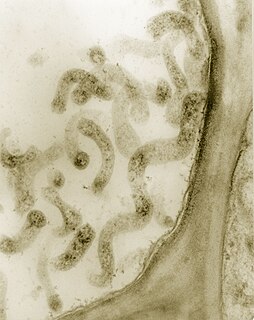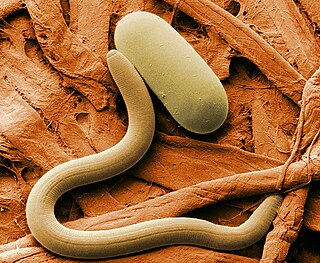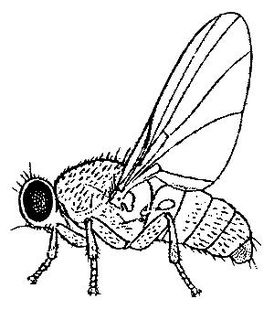
Spiroplasma is a genus of Mollicutes, a group of small bacteria without cell walls. Spiroplasma shares the simple metabolism, parasitic lifestyle, fried-egg colony morphology and small genome of other Mollicutes, but has a distinctive helical morphology, unlike Mycoplasma. It has a spiral shape and moves in a corkscrew motion. Many Spiroplasma are found either in the gut or haemolymph of insects where they can act to manipulate host reproduction, or defend the host as endosymbionts. Spiroplasma are also disease-causing agents in the phloem of plants. Spiroplasmas are fastidious organisms, which require a rich culture medium. Typically they grow well at 30 °C, but not at 37 °C. A few species, notably Spiroplasma mirum, grow well at 37 °C, and cause cataracts and neurological damage in suckling mice. The best studied species of spiroplasmas are Spiroplasma poulsonii, a reproductive manipulator and defensive insect symbiont, Spiroplasma citri, the causative agent of citrus stubborn disease, and Spiroplasma kunkelii, the causative agent of corn stunt disease.
Pratylenchus brachyurus is a plant parasitic nematode.
Helicotylenchus multicinctus is a plant pathogenic nematode that affects primarily bananas and plantains. Nematodes of the genus Helicotylenchus are spiral nematodes and feed on a large variety of plant species.

Heterodera is a genus of nematodes in the family Heteroderidae. Members of the genus are obligate parasites and different species attack different crops, often causing great economic damage. The genus is unique among nematode genera because of the ability of the female to transform into a tough, brown, cyst which protects the eggs which have been formed within her body. The name heterodera "refers to the different 'skins' of female and cyst."

Anguina agrostis is a plant pathogenic nematode.

Anguina is a genus of plant pathogenic nematodes.
Tylenchorhynchus is a genus of nematodes including many species of plant parasites. The classification of stunt nematodes - those including the genus Tylenchorhynchus - is unstable; many newly discovered species within this genus are reconsidered to be actually subspecies. Stunt nematodes such as Tylenchorhynchus and the closely related genera, Anguillulina and Merlinia, include more than 250 known species. Members of these genera possess similar anatomy and may be easily mistaken for one another. Some debate has led to the classification of single species under different names in two distinct genera.

The nematodes or roundworms constitute the phylum Nematoda, with plant-parasitic nematodes being known as eelworms. They are a diverse animal phylum inhabiting a broad range of environments. Taxonomically, they are classified along with insects and other moulting animals in the clade Ecdysozoa, and unlike flatworms, have tubular digestive systems with openings at both ends. Like tardigrades they have a reduced number of Hox genes, but as their sister phylum Nematomorpha has kept the ancestral protostome Hox genotype, it shows that the reduction has occurred within the nematode phylum.
Antarctica is one of the most physically and chemically extreme terrestrial environments to be inhabited by lifeforms. The largest plants are mosses, and the largest animals that do not leave the continent are a few species of insects.

Louis-Joseph Alcide Railliet was a French veterinarian and helminthologist.
Legerella is a genus of parasitic alveolates of the phylum Apicomplexa. Species in this genus that usually infect the malpighian tubules of invertebrates.
Tylenchidae is a family of nematodes containing the following subfamilies and genera:
Aphelenchoididea is a nematode superfamily in the order Rhabditida. Its members can be found inside bodies of species from the families Lepidoptera and Blattodea.
TrilobusBruennich, 1781 is a disused genus of trilobites, the species of which are now all assigned to other genera.
Aphelenchus is a genus of nematode in the family Aphelenchoididae. Member species inhabit soil and feed on fungi.
Ironus is a genus of nematodes.
Tylenchus elegans is a species of marine nematodes in the family Tylenchidae and subfamily Tylenchinae. It is from the Gulf of Naples, Italy.
Plectus parvus is a species of nematode (roundworm) found in freshwater and terrestrial environments. It has been sampled in Europe and New Zealand. Along with the similar nematode Panagrolaimus detritophagus, in 2018 it was the first species of multicellular eukaryote to be thawed into a living state after prolonged cryopreservation. Female worms of this species were found in Pleistocene permafrost in the Kolyma River lowland. They were mobile and ate, after being frozen for 30–40 thousand years.

Fergusonina, the sole genus in the family of Fergusoninidae, are gall-forming flies. There are about 40 species in the genus, all of them producing galls on Eucalyptus, Melaleuca, Corymbia, and Metrosideros species in Australia and New Zealand.
Tripyla is a genus of Nematoda belonging to the family Tripylidae.






